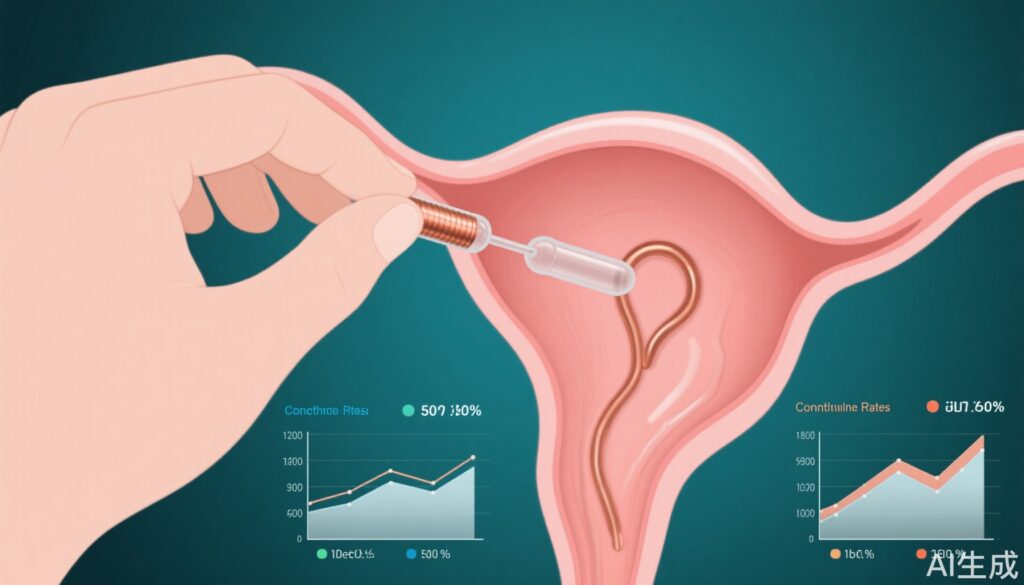Highlights
- The NTCu380 Mini copper IUD demonstrated similar contraceptive efficacy to the TCu380A over three years in predominantly nulliparous women.
- Discontinuation due to adverse events was significantly lower for the NTCu380 Mini, notably for bleeding and pelvic pain.
- Both devices are associated with a low risk of serious adverse events, with no significant difference detected.
- The findings support the NTCu380 Mini as a favorable option for nulliparous women seeking long-term, non-hormonal contraception.
Study Background and Disease Burden
Intrauterine devices (IUDs) are among the most effective reversible contraceptives, boasting failure rates below 1% per year in typical use. However, acceptability, continuation, and side effect profiles differ by device design and patient characteristics, especially in nulliparous individuals, who often experience higher rates of IUD-related discomfort or bleeding. The standard TCu380A copper IUD, widely used in the United States, is sometimes associated with adverse events leading to discontinuation, potentially limiting its utility in younger or nulliparous women. An unmet need exists for alternative devices that maintain efficacy but improve side effect tolerability to support broader contraceptive choice and adherence, which is directly linked to reduction in unintended pregnancies.
Study Design
In a multicenter, randomized, open-label trial, Schreiber et al. evaluated the contraceptive efficacy, safety, and continuation profile of the NTCu380 Mini—a 380-mm2 copper IUD available in Europe and Canada—compared to the TCu380A, the standard 380-mm2 copper IUD in the United States. Participants aged 16-40 years were randomized in a 4:1 ratio to receive either the NTCu380 Mini or TCu380A and followed for up to 37 months. Nulliparity was prominent in both groups (83.9%). The primary endpoint was the Pearl Index (number of pregnancies per 100 woman-years) for NTCu380 Mini users aged 35 and under. Secondary outcomes included time to pregnancy (via survival analysis), adverse event (AE) rates, and device continuation rates.
Key Findings
A total of 887 participants were assigned to the NTCu380 Mini and 218 to TCu380A. Successful placement was achieved in 98.6% and 97.7% of participants, respectively. The NTCu380 Mini demonstrated a 3-year cumulative Pearl Index of 1.86 (95% CI, 1.20–2.74) pregnancies per 100 woman-years among users ≤35 years of age. The cumulative 3-year pregnancy rate was 4.8% (95% CI, 2.8–6.9%).
Serious adverse events were uncommon: 3.5% in the NTCu380 Mini group and 1.9% in the TCu380A group (P=0.28), with no statistically significant difference. Discontinuation for any cause occurred in 51.3% of NTCu380 Mini and 57.3% of TCu380A users (P=0.07), suggesting a trend toward better continuation with the Mini device. Notably, discontinuation due to adverse events was significantly less frequent in NTCu380 Mini users (20.8% vs. 33.2%; P=0.001), as was discontinuation specifically due to bleeding or pelvic pain (14.5% vs. 27.3%; P<0.001).
These results underscore that while both devices provide robust contraceptive efficacy in a predominantly nulliparous population, the NTCu380 Mini is associated with a more favorable side effect profile leading to higher continuation rates.
Expert Commentary
The tolerability of copper IUDs remains a key determinant of continuation, especially in nulliparous and younger women. The lower rate of discontinuation due to bleeding and pelvic pain with the NTCu380 Mini suggests that device size or design modifications may alleviate some of the most common reasons for IUD removal. This is clinically significant, as higher continuation rates are directly linked to lower rates of unintended pregnancy and improved reproductive autonomy. Notably, the absolute efficacy (Pearl Index and pregnancy rate) of the NTCu380 Mini remains within the realm of highly effective contraception, although a 3-year cumulative pregnancy rate approaching 5% should be interpreted in the context of real-world use and patient counseling. Further research may clarify the generalizability of these findings to multiparous women or to populations with different baseline characteristics.
Conclusion
The NTCu380 Mini copper IUD offers a comparable, highly effective contraceptive option to the widely used TCu380A, with a significantly better side effect profile leading to improved device continuation, particularly among nulliparous women. These findings support the consideration of the NTCu380 Mini as a first-line non-hormonal contraceptive option in clinical practice, especially for individuals prioritizing both efficacy and tolerability. Ongoing surveillance and real-world data will further elucidate its long-term impact on contraceptive success and patient satisfaction.
References
1. Schreiber CA, Nanda K, Hubacher D, Turok DK, Jensen JT, Creinin MD, et al. Contraceptive Efficacy and Comparative Side Effects of a Mini Copper Intrauterine Device. NEJM Evid. 2025 Aug;4(8):EVIDoa2400480. doi: 10.1056/EVIDoa2400480.
2. Winner B, Peipert JF, Zhao Q, et al. Effectiveness of long-acting reversible contraception. N Engl J Med. 2012;366(21):1998-2007. doi:10.1056/NEJMoa1110855.
3. ACOG Practice Bulletin No. 186: Long-Acting Reversible Contraception: Implants and Intrauterine Devices. Obstet Gynecol. 2017;130(5):e251-e269.



